Putting together Top 10 lists is a popular thing for websites to do at the end of the year.
I generally avoid trends, but I like this one, because the process of stepping back and getting perspective on what you've experienced and achieved over the preceding 12 months is an excellent way to set goals for the upcoming year.
It's also a nice opportunity to recap and share some highlights of the year...to recall the good times, as well as the challenges.
I've just skimmed through my blog posts from 2011, and picked out ten of my favourite photos, listed in chronological order.
The first is this image of Ron Leidich and Terry Ward in the entrance of one of the hidden lakes in Palau's Rock Islands:
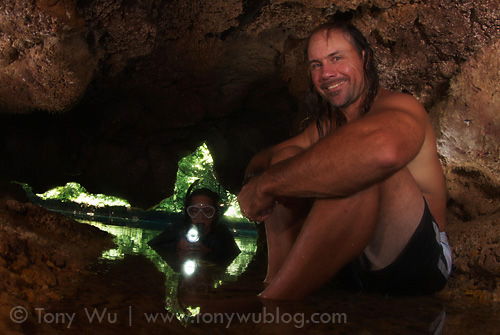
Ron and Terry in a tunnel leading to a hidden lake in Palau's Rock Islands
I like this picture because it encapsulates everything about the unique and educational experience I had in February of exploring Palau by kayak. Getting into and out of concealed lakes was often a logistical challenge, to say nothing of the difficulty involved in documenting the experience with photos.
To capture this image, I had to swim several times between our mother boat and the island in order to haul my gear up and over sharp rocks and hydroids into the narrow opening, then get Ron and Terry into position and set up the lighting before ambient light levels fell and the incoming tide trapped us.
We were on a tight schedule and only had one try, with a window of 20, no more than 30, minutes, so I was elated (shocked almost!) when the shot actually worked.
The second photo I picked from the trip is a more traditional underwater image of a coral reef in shallow water.
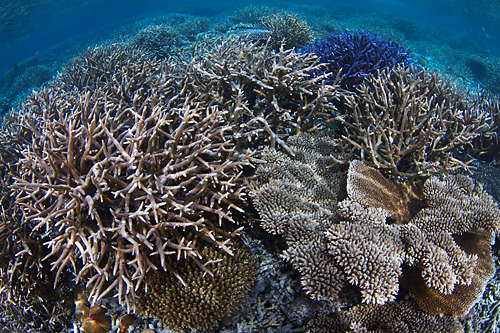
Thriving coral reef in an area that was devastated by
El Niño in 1998 and crown of thorns thereafter
It's not technique, lighting, composition, etc. that makes this photo stand out for me. It's the fact that this reef is living testimony to the tremendous self-healing and recovery capability of Mother Nature. It's a symbol of hope…a reef system that defied all the doom-and-gloom, end-of-days pronouncements by experts in the wake of the massive El Niño in 1998. It's cause for optimism.
Next up are two photos of Australian sea lions (Neophoca cinerea), the first of a friendly young sea lion coming in to give my camera a neighborly nuzzle and kiss:
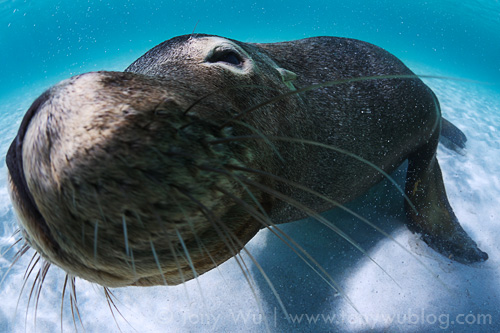
Young Australian sea lion coming in for a kiss
…and the second of two sea lions play-fighting:
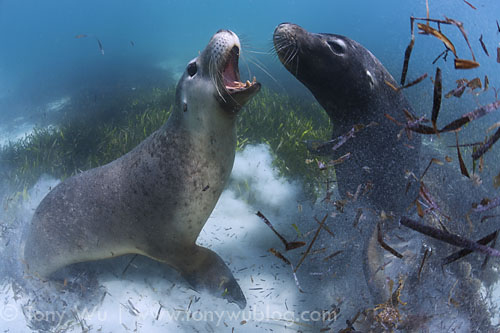
Two male sea lions having a friendly discussion
I love interacting with pinnipeds, and these two photos taken together show the extremes of their behaviour. If you're a dog-lover like me, you'll have no problem imagining what it's like to swim with these precocious animals. It's like being surrounded by hyperactive labrador retrievers...except that you're in the water, and they can swim (a lot!) better than you.
A shadow hung over my time with the sea lions this year, as the earthquake+tsunami+nuclear reactor meltdowns in Japan took place just as I arrived in Western Australia, but the fact that I was with great friends (including three terrific kids who had an absolute blast with the sea lions) helped to balance things out.
I'm planning a return visit in March 2013, so let me know if you're interested.
Pretty soon after playing with the sea lions, I took an exploratory trip to Sri Lanka, where I had some amazing luck. Among the highlights was an encounter with a manta ray that head-butted me twice:

Rear view of a manta ray feeding at the ocean surface
I like this angle, because it's different from most manta images. It took a lot of swimming and a number of attempts to get the manta's tail lined up just right, when the tips of both of the animal's wings were out of the water.
The back story of this head-butting manta is interesting, and worth a read if you like enigmas. Naturally, there was some debate about whether the manta really made a sound or not before colliding with me.
I'm 100% certain of what I heard, and there was another person in the water with me who heard/ saw the exact same things. Capt. Craig of Golden Dawn also reported a similar sound from a manta in PNG; I've appended a note to my original blog post with Craig's comments. Have a read, and please let me know if you come across mantas (or other rays) making odd sounds.
Also during that trip, I managed to swim through the biggest cloud of sperm whale poo I've come across so far. You gotta admit, it's impressive!
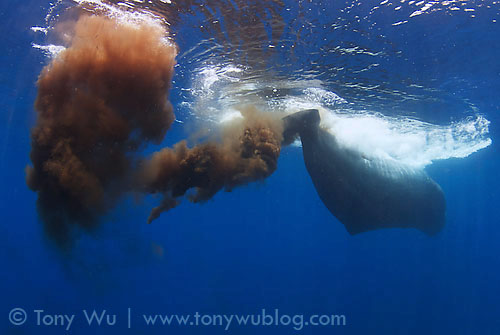
This is the biggest dump I’ve ever seen from a sperm whale.
You might think it odd that I'd pick such a photo for my ten favourites of the year, but c'mon, no one can resist gawking at that enormous effluent emission.
As if batoid head-butts and odontocete defecation weren't amazing enough, I had the mind-blowing experience of having two blue whales swim toward me, slow down to make eye contact, wish me a good day, then merrily carry on with their official whale business:
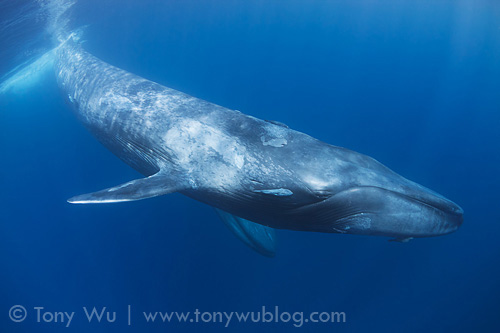
Blue whales(!) swimming in blue water
In case there was any doubt, I can confirm that blue whales are...big!
Then it was off to Papua New Guinea, where I spent a month aboard MV Golden Dawn, harassing Captain Craig and Bob Halstead.
I didn't do much macro photography this year, but on this trip, I nailed a super-macro shot of Dinah's goby (Lubricogobius dinah), a fish I've been wanting to photograph for a decade or so:
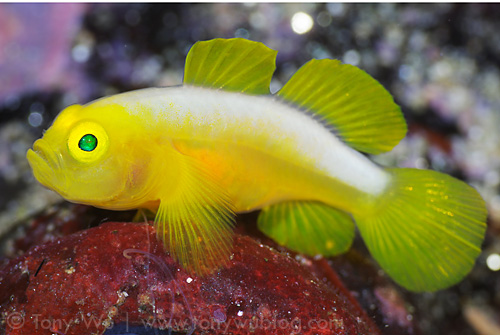
Super-macro shot of Dinah’s goby (Lubricogobius dinah)
Photographing Dinah's goby involved using a rebreather, lugging an elaborate camera set-up, and putting in some deco time, but it was worth the effort. Bob and Dinah Halstead documented this fish and had it described, so it was an honour to have Bob find the fish for me, and to be able to help Bob get a print made for Dinah!
My final two picks for the year are from Tonga. It was such an amazing season, with a record 48 humpback whale mother/ calf pair IDs, that it's extremely difficult to select just two photos.
This picture is special because the adult female is one that I first photographed and ID-ed in 2009. I recognised her immediately on sight. She had the same even-keeled temperament that she did two seasons ago, and her calf was playful, confident and friendly, just like her calf in 2009.
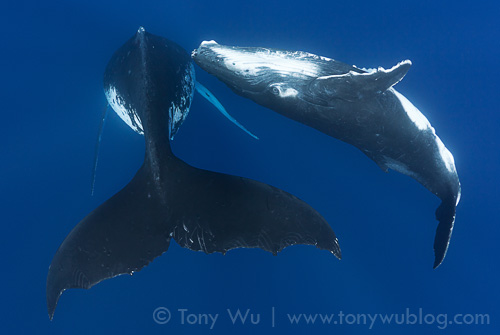
Toluua, humpback whale calf #32 of the 2011 season, with mommy
And last but not least, I am quite fond of this photo of a male humpback whale singing:
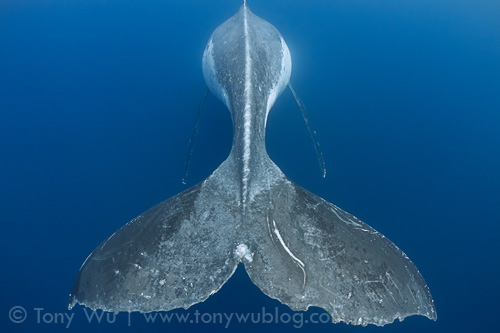
Fluke of a humpback whale singer
I've spent time with and photographed a lot of singers, but this had to be the most cooperative one ever. From the moment we made eye contact, I could tell that the whale didn't mind my presence. The white along the sides of its body, and the curly, twisty scar on the right side of its fluke really give the whale character, making for a beautiful portrait of a beautiful animal.
Well...there are certainly many more photos that I liked, but a Top 47 list doesn't have quite the same ring to it as Top 10 does.
All of these images are more than just pictures to me. They are reminders of incredible experiences, of memories and lessons learned that no amount of money can buy, of another year well spent exploring the world, making friends, and...hopefully...becoming a better photographer and person.